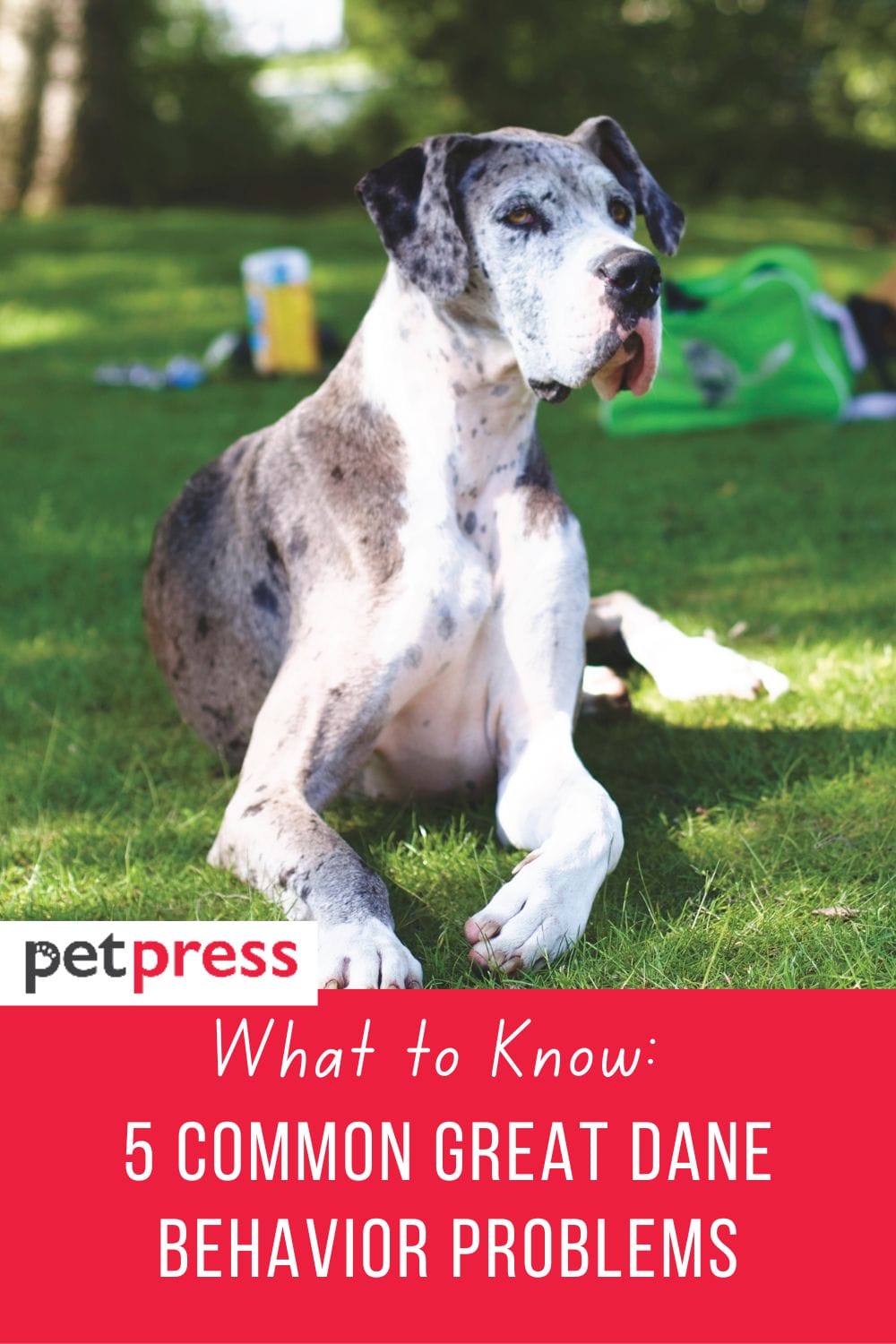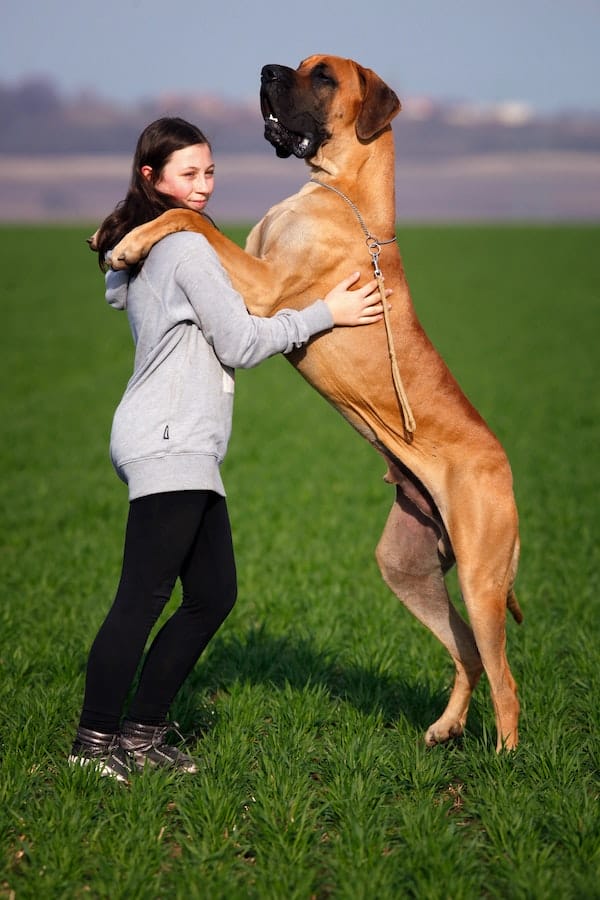
Do you happen to be the proud owner of a majestic Great Dane?
These gentle giants are renowned for their impressive stature and endearing personalities.
However, like any other breed, Great Danes can sometimes display certain behavior issues that might leave you a bit puzzled.
In this comprehensive guide, we’ll dive deep into the realm of Great Dane behavior.
We’ll explore their unique traits, delve into the most common behavioral challenges they might encounter, and offer you some valuable insights and tips on how to effectively prevent and address these issues.
Let’s embark on this journey together, aiming to foster a harmonious and fulfilling bond with your cherished Great Dane companion.
Great Dane Characteristics and Traits
Great Danes are undoubtedly one of the most remarkable dog breeds out there.
Their towering height and elegant appearance make them stand out in a crowd.
But what lies beneath their impressive exterior?
Let’s take a closer look at some key characteristics and traits that define Great Danes:
Gentle giants
Great Danes, frequently referred to as “Gentle Giants,” are a breed known for their surprisingly delicate and well-disposed nature.
Their overwhelming size might be scary from the outset, however, underneath that height lies a kind nature.
They are genuinely affectionate animals and make outstanding family pets.
What’s truly special is how their gentle nature shines, especially when interacting with children.
They exhibit remarkable patience and care, making them an ideal choice for families seeking a loyal and gentle companion.
Loyal companions
Loyalty is a defining trait of Great Danes.
These dogs are renowned for forming profound bonds with their human family members.
Once they’ve forged a connection with their owners, they become fiercely protective and are always ready to offer comfort and solace.
This unwavering loyalty elevates them from being mere pets to integral members of the family.
Moderate energy levels
In terms of energy levels, Great Danes are quite different from more hyperactive breeds.
They maintain a moderate level of energy, not requiring constant activity.
Instead, they are content with lounging around the house, which aligns well with households leading a more relaxed lifestyle.
However, it’s crucial to remember that they still need regular exercise to stay healthy and avoid the common issue of obesity, especially given their larger size.
Social butterflies
Great Danes are genuine social butterflies.
They thrive on human interaction and often bask in being the center of attention.
This sociable nature, while endearing, can lead to separation anxiety if they are left alone for extended periods.
Owners should prioritize spending quality time with their Great Danes to ensure they receive the companionship and affection they so deeply desire.

Most Common Great Dane Behavior Problems
Now that we’ve explored what makes Great Danes unique, let’s dive into the behavior problems that are commonly associated with this breed:
Separation anxiety
Great Danes are known to be prone to separation anxiety.
When left alone for extended periods, they can become anxious and resort to destructive behaviors, such as chewing furniture or incessant barking.
To alleviate this issue, gradual desensitization to your departures can help. Start by leaving for short intervals and gradually increasing the time you’re away.
Providing toys or puzzles that engage their minds can also keep them occupied.
Jumping on people
Great Danes, owing to their size, may have a natural tendency to jump on people, which can be a concern for both their safety and the comfort of others.
Training is key to curbing this behavior.
Teaching them commands like “sit” and “stay” can be immensely helpful.
Encourage guests to ignore your Dane until they settle down, rewarding them for calm behavior.
Consistency and positive reinforcement are essential in breaking this habit.
Leash pulling
Walking a Great Dane that pulls on the leash can be challenging.
To address this issue, leash training is crucial. Start with a well-fitting harness or head collar that provides better control.
Practice loose leash walking in a controlled environment, rewarding your dog for walking without tension on the leash.
Consistent and patient training sessions are essential to reinforce good walking behavior.
Aggression
While Great Danes are generally friendly, some individuals may exhibit aggression if not properly socialized or trained.
Early socialization with other dogs and people is vital to prevent aggressive tendencies.
If aggression issues arise, consult with a professional dog trainer or behaviorist to assess the underlying causes and implement a tailored training plan.
Positive reinforcement techniques can often help modify aggressive behavior.
Barking
Great Danes have a reputation for being vocal, and excessive barking can be a concern.
To reduce unnecessary barking, training them to bark on command and rewarding them for being quiet can be effective.
Identifying triggers for their barking, such as strangers or other dogs, can help address the root causes.
Additionally, ensuring they receive enough mental and physical stimulation through play and exercise can reduce boredom-related barking.

Tips for Prevention and Training Great Dane Behavior Problems
Preventing and addressing behavior problems in Great Danes is crucial for a happy and harmonious life with your furry friend.
Here are some practical tips to help you tackle these issues effectively:
Early socialization
Initiating the socialization process for your Great Dane at a young age is paramount in preventing potential issues like aggression and anxiety.
Introducing them to various environments, people, animals, and experiences while they are still puppies can help them grow into well-adjusted adults.
This exposure should be gradual and positive, ensuring that your Great Dane associates new encounters with positive feelings.
Positive reinforcement
Positive reinforcement techniques are powerful tools in shaping your Great Dane’s behavior.
Use rewards such as treats, praise, and affection to reinforce good behavior and discourage unwanted actions.
This approach fosters a positive and trusting relationship between you and your dog while motivating them to repeat desired behaviors.
Consistent training
Consistency is the cornerstone of effective training for Great Danes.
Establish clear boundaries and expectations, and be unwavering in enforcing them.
When everyone in the household adheres to the same rules, it prevents confusion for your dog.
Consistency in commands, routines, and consequences helps your Great Dane understand what is expected of them, leading to better behavior overall.
Exercise and mental stimulation
Great Danes, despite their moderate energy levels, require regular exercise and mental stimulation.
These activities not only keep them physically fit but also prevent boredom-related behavior problems.
Engaging in activities such as interactive toys, obedience training, and structured playtime can keep their minds active and prevent destructive tendencies that may arise from boredom.
Seeking professional help
When you find yourself dealing with persistent or challenging behavioral issues with your Great Dane, it’s a prudent choice to seek professional assistance.
Enlisting the expertise of professional dog trainers and behaviorists can prove immensely beneficial.
These experts possess the knowledge and experience to thoroughly evaluate your Great Dane’s unique issues and craft a customized training plan to effectively address them.
Their guidance can be invaluable in resolving complex problems, ultimately fostering a harmonious and fulfilling relationship between you and your canine companion.

Conclusion
Great Danes are indeed wonderful companions, but they do require a solid understanding, care, and proper training to truly thrive as pets.
Taking the time to familiarize yourself with their distinctive characteristics and recognizing potential behavioral challenges enables you to take proactive steps.
This proactive approach ensures a life filled with joy and fulfillment for both you and your beloved Great Dane.
FAQs
Yes, Great Danes are generally good with children. They are known for their gentle nature and often form strong bonds with kids. However, supervision is always recommended when any dog is around children.
Great Danes have moderate energy levels and require daily exercise. A couple of brisk walks and some playtime in a secure area should suffice.
While Great Danes can adapt to apartment living, it’s important to provide them with enough space to move around comfortably. Regular exercise is essential, even in smaller living spaces.


GIPHY App Key not set. Please check settings